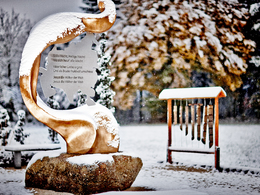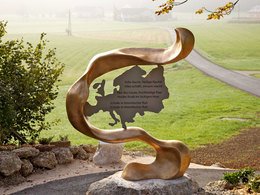Gemeindeamt Hochburg-Ach
5122 Hochburg-Ach

Hochburg-Ach currently has a population of 3,133 (as of 2015).
The municipality belongs to the district of Braunau am Inn in the Innviertel region and is located on the Salzach river directly opposite the Bavarian town of Burghausen with the world's longest castle. Franz Xaver Gruber, the composer of "Silent Night", was born here.
The Carolingian King Karlmann, eldest son of Ludwig the German, liked to stay in the Palatinate of Ötting with his court entourage. In this year, he signed three documents at the royal court "curtis regia" at "Hohberahha". This involved an exchange of goods between Bishop Embricho of Regensburg and his nephew Abbot Hatto of Mondsee. The Carolingian farmstead, which is said to have been located on the site of today's Hofergut, owes its location on the water-poor plateau to the nearby spring. It is known as a baptismal spring and a baptismal chapel was built next to it. It is likely that birch trees grew here, after which the settlement was named. The interpretation that the name is derived from the Ahd. The interpretation that the name is based on the Ahd. root word "ber(a)h", "berc" (= birch) is quite conceivable. The name "Hoberahha" (= high birch forest) changed over time to "Hoberc", "Hoperc" and similar. From the 16th century we read "Hochburg".
After the death of Emperor Henry II (1024), the royal courts of Hoberc, Ranshofen, Ostermiething and the Weilhart belonged to the imperial widow Kunigunde. In the 12th century, the Bavarian dukes became fiefs and sovereigns. The clearing around the Königshof, now called Wirtschaftshof and Krauthof, was pretty much completed by the 13th century. The Wirschaftshof, owned by the dukes, falls apart and a Wolfgang Hofer and a Wolf Neuhauser appear as owners of the divided farm.
The Kastner von Burghausen administered the area on behalf of the dukes. He was assisted by henchmen. Around 1340, "Cunrat der Scherge" sat at his official residence in Mitterndorf, today's "Schörghube", and administered the Obmannschaft Hochburg, Gilgenberg, Handenberg (southern part), Eggelsberg, Moosdorf and Geretsberg. This official residence is known to have existed until the 16th century.
The place of pilgrimage Maria Ach, whose name comes from the Ahd. The place of pilgrimage Maria Ach, whose name is derived from the Old German word "ahe" (= water or watercourse larger than a stream), has been closely linked to the neighbouring Bavarian town of Burghausen since its foundation. Around 1180, Ach and at the same time the "Acher" family first appear in a document in which a "Herbrodus de Ache" is mentioned. In 1354, "Heinrich der Acher" is named as the owner of Wanghausen Castle and the Hofmark. Their successors, the Khematers, were granted Wanghausen by a charter from Duke Albrecht IV. Wanghausen to them. In addition, some farmers in Lindach and Mitterndorf were subject to feudal obligations. Until the annexation of the Innviertel region to Austria in 1779, Ach belonged to the town of Burghausen. Hochburg-Ach has existed as a free political municipality since 31 August 1864, when the municipal regulations of 28 April 1864, issued on the basis of the Imperial Municipalities Act 1862 in Upper Austria, became legally binding in Hochburg-Ach.
5122 Hochburg-Ach
Phone +43 7727 2255
E-Mail gemeinde@hochburg-ach.ooe.gv.at
Web www.hochburg-ach.at
Web www.seelentium.at/index.php?id=79
http://www.seelentium.at/index.php?id=79
Contact person
Mr Amtsleiter Erwin Eberharter
Gemeinde Hochburg-Ach
Athalerstraße 3
5122 Hochburg-Ach
Phone +43 7727 2255 - 11
E-Mail gemeinde@hochburg-ach.ooe.gv.at
Web www.hochburg-ach.at
- Saturday
- Sunday
- holiday
- Spring
- Summer
- Autumn
- Winter
Please get in touch for more information.



